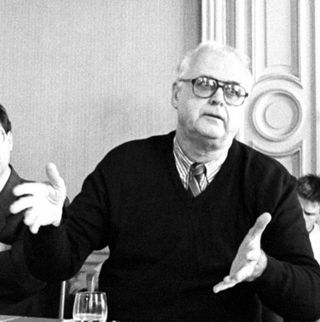Related Research Articles

Villa Savoye is a modernist villa and gatelodge in Poissy, on the outskirts of Paris, France. It was designed by the Swiss-French architect Le Corbusier and his cousin Pierre Jeanneret, and built between 1928 and 1931 using reinforced concrete.

Richard Meier is an American abstract artist and architect, whose geometric designs make prominent use of the color white. A winner of the Pritzker Architecture Prize in 1984, Meier has designed several iconic buildings including the Barcelona Museum of Contemporary Art, the Getty Center in Los Angeles, the High Museum of Art in Atlanta, and San Jose City Hall. In 2018, some of Meier's employees accused him of sexual assault, which led to him resigning from his firm in 2021.

The International Style or internationalism is a major architectural style that was developed in the 1920s and 1930s and was closely related to modernism and modernist architecture. It was first defined by Museum of Modern Art curators Henry-Russell Hitchcock and Philip Johnson in 1932, based on works of architecture from the 1920s. The terms rationalist architecture and modern movement are often used interchangeably with International Style, although the former is mostly used in the English-speaking world to specifically refer to the Italian rationalism, or even the International Style that developed in Europe as a whole.

Peter David Eisenman is an American architect, writer, and professor. Considered one of the New York Five, Eisenman is known for his high modernist and deconstructive designs, as well as for his authorship of several architectural books. His work has won him several awards, including the Wolf Prize in Arts.

Postmodern architecture is a style or movement which emerged in the late 1950s as a reaction against the austerity, formality, and lack of variety of modern architecture, particularly in the international style advocated by Philip Johnson and Henry-Russell Hitchcock. The movement was introduced by the architect and urban planner Denise Scott Brown and architectural theorist Robert Venturi in their 1972 book Learning from Las Vegas. The style flourished from the 1980s through the 1990s, particularly in the work of Scott Brown & Venturi, Philip Johnson, Charles Moore and Michael Graves. In the late 1990s, it divided into a multitude of new tendencies, including high-tech architecture, neo-futurism, new classical architecture, and deconstructivism. However, some buildings built after this period are still considered postmodern.

Robert Arthur Morton Stern is a New York City–based architect, educator, and author. He is the founding partner of the architecture firm, Robert A. M. Stern Architects, also known as RAMSA. From 1998 to 2016, he was the Dean of the Yale School of Architecture.
Starchitect is a portmanteau used to describe architects whose celebrity and critical acclaim have transformed them into idols of the architecture world and may even have given them some degree of fame among the general public. Celebrity status is generally associated with avant-gardist novelty. Developers around the world have proven eager to sign up "top talent" (i.e., starchitects) in hopes of convincing reluctant municipalities to approve large developments, of obtaining financing or of increasing the value of their buildings. A key characteristic is that the starchitecture is almost always "iconic" and highly visible within the site or context. As the status is dependent on current visibility in the media, fading media status implies that architects lose "starchitect" status—hence a list can be drawn up of former "starchitects".

John Quentin Hejduk was an architect, artist and educator from New York City. Hejduk studied at the Cooper Union School of Art and Architecture, the University of Cincinnati, and the Harvard Graduate School of Design. He worked in several offices in New York including that of I. M. Pei and the office of A.M. Kinney. He established his own practice in New York City in 1965.

Rudolph Hall is one of the earliest and best-known examples of Brutalist architecture in the United States. Completed in 1963 in New Haven, Connecticut, the building houses Yale University's School of Architecture. Until 2000, it also housed the School of Art.

The Yale School of Architecture (YSoA) is one of the constituent professional schools of Yale University. The School awards the degrees of Master of Architecture I, Master of Architecture II, Master of Environmental Design (M.E.D), and Ph.D in architectural history and criticism. The School also offers joint degrees with the Yale School of Management and Yale School of the Environment, as well as a course of study for undergraduates in Yale College leading to a Bachelor of Arts. Since its founding as a department in 1916, the School has produced some of the world's leading architects, including Norman Foster, Richard Rogers, Maya Lin and Eero Saarinen, among others. The current dean of the School is Deborah Berke.

Kenneth Brian Frampton is a British architect, critic and historian. He is regarded as one of the world's leading historians of modernist and contemporary architecture. He is an Emeritus Professor of Architecture at the Graduate School of Architecture, Planning, and Preservation at Columbia University, New York, where he taught for over 50 years. He is a citizen of Britain and the United States.

The University of Cincinnati College of Design, Architecture, Art, and Planning (DAAP) is an arts and architecture college of the University of Cincinnati in Cincinnati, Ohio. It was initially established as the School of Applied Art in 1926.
Colin Rowe was a British-born, American-naturalised architectural historian, critic, theoretician and teacher. He is acknowledged to have been a major theoretical and critical influence in the second half of the twentieth century on world architecture and urbanism. During his life he taught briefly at the University of Texas at Austin and, for one year, at the University of Cambridge in England. For most of his life he was a professor at Cornell University in Ithaca, New York. Many of Rowe’s students became important architects and extended his influence throughout the architecture and planning professions. In 1995 he was awarded the Gold Medal by the Royal Institute of British Architects, its highest honor. He was also awarded the Athena Medal from the Congress for the New Urbanism posthumously in 2011.
Feminist theory as it relates to architecture has forged the way for the rediscovery of such female architects as Eileen Gray. These women imagined an architecture that challenged the way the traditional family would live. They practiced architecture with what they considered feminist theories or approaches. The rediscovery of architecture through feminist theory is not limited to female architects. Architects like Le Corbusier and Adolf Loos have also had their architecture reexamined through feminist theory.
Gwathmey Siegel Kaufman & Associates Architects LLC is a New York City-based architectural firm founded in 1967 by architects Charles Gwathmey and Robert Siegel.

The Institute for Architecture & Urban Studies is a non-profit architecture studio and think tank located in Manhattan, New York, United States. The original Institute existed from 1967 to 1984, where it was a hub for experimental architectural discourse and practice. It re-opened in 2003 as a non-profit offering individualized summer architecture studios.
Kenneth Michael Hays is an American architectural historian and professor. He currently serves as Eliot Noyes Professor of Architectural Theory at Harvard University's Graduate School of Design. He is also co-director of the school's doctoral programs, namely Ph.D and DDes or Doctor of Design.

Hélène Binet is a Swiss-French architectural photographer based in London, who is also one of the leading architectural photographers in the world. She is most known for her work with architects Daniel Libeskind, Peter Zumthor and Zaha Hadid, and has published books on works of several architects.

The Smith House is a work of contemporary architecture designed by Richard Meier, a well-known architect born in 1934 who led the avant-garde modern architecture movement of the 1960s. The Smith House was planned starting in 1965 and completed in 1967 in Darien, Connecticut, and overlooks the Long Island Sound from the Connecticut coast. The 2,800 square-foot home has been featured in numerous books and has won various prestigious awards.

Learning from Las Vegas is a 1972 book by Robert Venturi, Denise Scott Brown, and Steven Izenour. Translated into 18 languages, the book helped foster the development of postmodern architecture.
References
- ↑ Goldberger, Paul (1996-02-11), "Architecture View: A Little Book That Led Five Men to Fame", The New York Times
- ↑ Hays, K. Michael (1988). Architecture Theory since 1968. Cambridge, MA: The MIT Press. pp. 239–240.
- ↑ "News Report: White, Gray, Silver, Crimson". Progressive Architecture: 26–32. July 1974.
- ↑ Drexler, Arthur (1975). "Preface". Five Architects. New York: Oxford University Press. p. 1.
- ↑ Anderson, Stanford O. (2013). "CASE and MIT Engagement". In Dutta, Arindam (ed.). A Second Modernism: MIT, Architecture, and the 'Techno-Social' Moment. MIT Press. pp. 642–643.
- ↑ Bletter, Rosemarie Haag (May 1979). "Review: Five Architects. Eisenman, Graves, Gwathmey, Hejduk, Meier; Five on Five". Journal of the Society of Architectural Historians. 38 (2): 205–207. doi:10.2307/989447. JSTOR 989447.
- ↑ Five Architects: Eisenman, Graves, Gwathmey, Hejduk, Meier. Oxford: Oxford University Press. 1975.
- ↑ Goldberger, Paul (November 26, 1973). "Architecture's '5' Make Their Ideas Felt". The New York Times.
- ↑ Kwun, Aileen; Smith, Bryn (2016). Twenty Over Eighty: Conversations on a Lifetime in Architecture and Design. New York: Princeton Architectural Press. pp. 52–63.
- ↑ Martin, Reinhold (2010). Utopia's Ghost: Architecture and Postmodernism, Again. Minneapolis, MN: University of Minnesota Press. p. 40.
- ↑ Stern, Robert A. M. (May 1973). "Stompin' at the Savoye". Architectural Forum: 46–48.
- ↑ Papademetriou, Peter (January 1971). "Le Corbusier à la mode, Revolution for the sell of it". Architectural Design: 24.
- ↑ "Five on Five". Architectural Forum: 46–57. May 1973.
- ↑ Cooke, Sekou (2021). Hip-hop architecture. London New York: Bloomsbury Visual Arts. ISBN 978-1-350-11617-7.
- ↑ Mallgrave, Harry Francis; Goodman, David (2011). An introduction to architectural theory: 1968 to the present. Malden (Mass.): Wiley-Blackwell. ISBN 978-1-4051-8063-4.